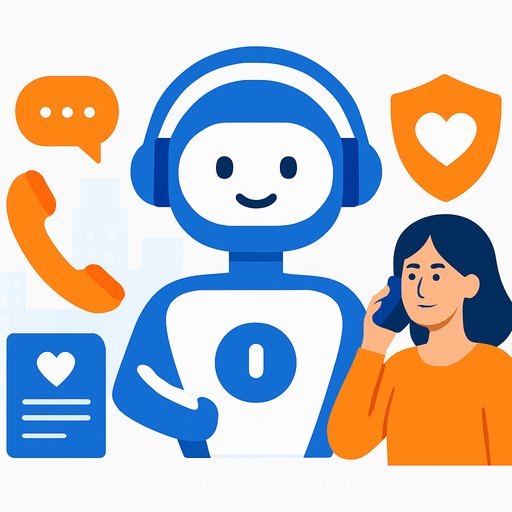Designing AI strategies to enhance customer trust and agent well-being in voice channels
Customer support is harder than it used to be. Fraud is up, caller behavior is tougher, and agents are stretched thin. At the same time, your team is expected to deliver fast, fair, and compliant assistance on every call. AI can help, but only if it's implemented with clear guardrails and a plan that protects people and brand trust.
A free one-hour webinar, "The Future of Customer Trust: Responsible AI in CX Voice Channels," lays out how retailers can responsibly deploy AI to handle calls and analyze voice interactions in real time. It focuses on balancing compliance with innovation, improving agent experience, and safeguarding customers from abuse and fraud.
Inside the free webinar
Mike Pappas, CEO and co-founder of Modulate, and John Walter, president of the Contact Center AI Association, share lessons drawn from the CCAIA's ethical AI principles and Modulate's experience analyzing tens of millions of hours of live voice conversations. Their goal is simple: give support leaders a practical roadmap you can apply this quarter, not next year.
If you run a contact center, lead CX operations, manage QA/compliance, or handle fraud prevention, this session is built for you. Expect strategic frameworks, real examples, and clear next steps.
Why this matters to support leaders
- Customers expect fast, transparent service-and zero tolerance for bias, spoofing, or abuse.
- Agents need protection from toxic conversations, unfair workloads, and burnout.
- Legal and risk teams need proof that AI decisions are explainable, auditable, and compliant.
- Operations teams need measurable gains in first contact resolution, QA, and containment without hurting CSAT.
Strategic frameworks you can use now
- Purpose and scope: Define where AI is helpful (authentication, summarization, QA, coaching) and where a human stays in control (disputes, sensitive complaints, exceptions).
- Transparency and consent: Notify callers when AI is assisting. Offer a human opt-out. Log disclosures for audits.
- Safety and fraud controls: Use voice spoofing and deepfake detection, step-up verification for risky actions, and real-time toxicity monitoring.
- Data governance: Minimize data collection, redact PII in transcripts, set strict retention, and restrict access by role and region.
- Fairness checks: Track outcomes across segments. Review false positives in fraud flags and escalations.
- Human-in-the-loop: Supervisors get alerts and can pause, intervene, or override AI guidance instantly.
- Agent well-being: Real-time de-escalation tips, automated after-call notes, balanced routing, and break nudges reduce strain.
- Metrics that matter: CSAT, FCR, containment rate, AHT distribution, QA pass rate, fraud prevention rate, and burnout indicators (after-call workload, adherence).
A practical rollout plan
- Start in "shadow mode" (AI observes, no actions) to baseline risk and accuracy.
- Red-team with worst-case calls: fraud attempts, heated complaints, accessibility needs.
- Pilot a narrow use case with strict guardrails and kill switches.
- Run A/B tests against current workflows. Measure both customer and agent impact.
- Co-design with agents: feedback loops, transparent scoring, and opt-in coaching.
- Document model behavior, escalation rules, and data flows for legal and compliance.
- Train supervisors on new dashboards, alerts, and intervention tools.
- Scale gradually, review weekly, and expand only after hitting quality thresholds.
What to ask AI and voice analytics vendors
- How is consent captured, disclosed, and logged? Can callers opt out easily?
- Do you provide spoofing/deepfake detection? What are your false positive/negative rates?
- Where is data stored and for how long? How is PII redacted from audio and text?
- Latency under load for real-time coaching? What's the uptime SLA?
- What audits and certifications do you hold (e.g., SOC 2)? How do you support PCI DSS scope reduction?
- Can supervisors pause or override AI in real time? Is there a visible audit trail?
- How do you track and report fairness across customer segments?
- What's your approach to prompt security, jailbreaks, and abuse handling?
High-impact use cases for retail contact centers
- Fraud defense: Voice spoof detection and step-up verification on high-risk changes or refunds.
- Real-time quality: Live coaching for empathy, compliance phrasing, and policy adherence.
- De-escalation: Toxicity alerts, suggested language, and quick routing to specialists.
- Post-call automation: Summaries, dispositions, and next-step tasks pushed to CRM.
- Payment capture: Auto-pause recording for card details to reduce PCI scope.
- New-hire acceleration: On-call guidance and checklists to shorten ramp time.
- Multilingual support: Real-time translation and sentiment cues for smoother handoffs.
Compliance guardrails to bake in
Spell out lawful basis and consent for recording and analysis. Keep a clear retention schedule, and ensure access is limited and logged. Publish a simple disclosure so customers know how AI assists their interaction and how to reach a human.
- Adopt an AI risk framework such as the NIST AI Risk Management Framework.
- Reduce scope for payments handling with PCI DSS best practices (pause/redact, secure storage).
- Follow regional requirements (e.g., GDPR, CCPA), TCPA for outbound, and STIR/SHAKEN for call authentication.
- Maintain full audit trails: who accessed what, when, and why.
The payoff: trust, performance, retention
Done right, AI doesn't replace the agent-it supports the agent and protects the customer. You get fewer escalations, faster resolution, and better QA coverage while reducing burnout. That combination builds trust you can measure.
Who's leading the conversation
The webinar features Mike Pappas (Modulate) and John Walter (Contact Center AI Association). They'll share field-tested lessons from large-scale voice analysis and ethical AI standards that you can apply immediately.
Want deeper training?
If your team needs structured upskilling on practical AI for support roles, explore curated programs by job function here: Complete AI Training: Courses by Job.
Your membership also unlocks:






